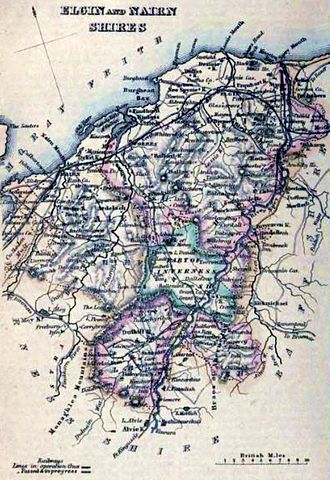Moray

"1861 MORAYSHIRE (Elginshire) & NAIRNSHIRE" by 1861 The Imperial Gazetteer of Scotland. VOL.II. Edited by Rev. John Marius Wilson.
Licensed under Public domain via Wikimedia Commons.
This website is in need of a new Coordinator - if you are interested, please contact Nathan
History
The word shire is of Old English origin, and meant charge, administration. The Norman Conquest introduced an alternative designation, the word county - through Old French from Latin comitatus, which in mediaeval documents stands for shire. County denotes the district under a count, the king's comes, the equivalent of the older English term earl. This system of local administration entered Scotland as part of the Anglo-Norman influence that strongly affected our country after 1100. Our shires differ in origin, and have arisen from a combination of causes - geographical, political and ecclesiastical. The boundaries, though often perplexing, have in the main been determined by the geographical features. Such is the case with Moray.
Formerly the Province of Moray embraced a very much larger area, including not only Nairn but also the greater part of the modern shires of Inverness and Ross. In early times the district was governed by mormaers who frequently acted independently of, or in opposition to, their nominal sovereign. But in the reign of David I the Province of Moray came to an end as a separate historical entity, and as a sign that he had incorporated it in the Scottish kingdom, David established a priory at Urquhart and a Cistercian abbey at Kinloss. Hence- forward Moray included "all the plain country by the seaside, from the mouth of the river Spey to the river of Farar or Beaulie, at the head of the Frith ; and all the valleys, glens and straths situated betwixt the Grampian Mountains south of Badenoch and the Frith of Moray, and which discharges rivers into that Frith." From time to time this area was still further reduced.
Till the latter half of the nineteenth century Morayshire consisted of two widely detached parts, separated by a portion of Inverness-shire. In order to get rid of the anomaly, "The Inverness and Elgin Boundaries Act" (1870) transferred part of the united parish of Inverallan and Cromdale from Inverness to Moray, and parts of the parishes of Abernethy and Duthil from Moray to Inverness. The boundaries of Moray were again rearranged by the Boundary Commissioners in 1891. Bellie and Rothes, parishes formerly partly in Morayshire, partly in Banffshire, were placed wholly in the former county, and Boharm, Inveravon and Keith in the latter. Of the parishes partly in Morayshire and partly in Nairnshire, Dyke and Moy was placed wholly in Morayshire; while the detached parts of the Nairnshire parish of Ardclach were transferred to the parish of Edinkillie. The parish of Cromdale had been partly in Inverness-shire and partly in Morayshire. The commissioners left the boundaries untouched by transferring the Inverness-shire part to the Inverness-shire parish of Duthil, and restricting the name of Cromdale to the Morayshire portion.
The name Moray is supposed to be an old locative plural of the Gaelic word muir, the sea. If this derivation be correct, Moray means "among the seaboard men." The designation is an apt one, for the Moray Firth is an all-important factor in the history of the district. As regards the derivation of Elgin, the other name for the county, authorities are completely at variance.
Matheson, Charles. Moray and Nairn. Cambridge: University Press, 1915.
Queries and Surnames
Submit and View Queries and Surnames Submit a Query or Surnames for your lost Moray Scotland ancestor. Please use the linking feature only for genealogical material otherwise your query may be deleted.
{all_weblinks}70{/all_weblinks}
